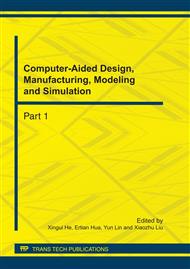p.515
p.524
p.531
p.537
p.545
p.549
p.554
p.559
p.564
Design of Pressure Sensor in Common Rail System by ANSYS Tools
Abstract:
A pressure sensor used in the Common Rail System is designed to monitor the oil pressure changing form 0 to 200MPa in the temperature from -40 to 130°C. It is composed of elastic cell, strain gage and signal processing circuit. Elastic cell produces liner strain with the oil pressure; strain gage transforms this strain into electrical signal that is enlarged and processed by signal processing circuit. To describe the relation of oil pressure with the strain, the stress distribution and strain of elastic cell with different shape is simulated, applying ANSYS tool in the 200MPa pressure. Then, an acceptable shape is produced and tested. It has the similar features with simulated result and works well.
Info:
Periodical:
Pages:
545-548
Citation:
Online since:
August 2011
Authors:
Keywords:
Price:
Сopyright:
© 2011 Trans Tech Publications Ltd. All Rights Reserved
Share:
Citation:


